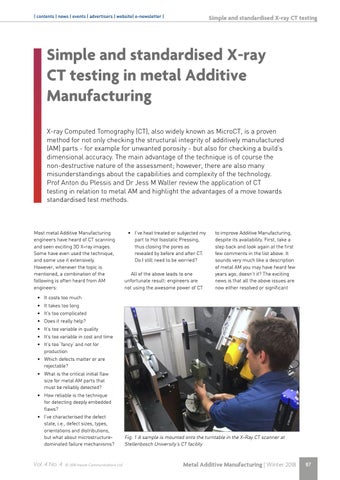| contents | news | events | advertisers | website| e-newsletter |
Simple and standardised X-ray CT testing
Simple and standardised X-ray CT testing in metal Additive Manufacturing X-ray Computed Tomography (CT), also widely known as MicroCT, is a proven method for not only checking the structural integrity of additively manufactured (AM) parts - for example for unwanted porosity - but also for checking a build’s dimensional accuracy. The main advantage of the technique is of course the non-destructive nature of the assessment; however, there are also many misunderstandings about the capabilities and complexity of the technology. Prof Anton du Plessis and Dr Jess M Waller review the application of CT testing in relation to metal AM and highlight the advantages of a move towards standardised test methods.
Most metal Additive Manufacturing engineers have heard of CT scanning and seen exciting 3D X-ray images. Some have even used the technique, and some use it extensively. However, whenever the topic is mentioned, a combination of the following is often heard from AM engineers:
• I’ve heat treated or subjected my part to Hot Isostatic Pressing, thus closing the pores as revealed by before and after CT. Do I still need to be worried? All of the above leads to one unfortunate result: engineers are not using the awesome power of CT
to improve Additive Manufacturing, despite its availability. First, take a step back and look again at the first few comments in the list above. It sounds very much like a description of metal AM you may have heard few years ago, doesn’t it? The exciting news is that all the above issues are now either resolved or significant
• It costs too much • It takes too long • It’s too complicated • Does it really help? • It’s too variable in quality • It’s too variable in cost and time • It’s too ‘fancy’ and not for production • Which defects matter or are rejectable? • What is the critical initial flaw size for metal AM parts that must be reliably detected? • How reliable is the technique for detecting deeply embedded flaws? • I’ve characterised the defect state, i.e., defect sizes, types, orientations and distributions, but what about microstructuredominated failure mechanisms?
Vol. 4 No. 4 © 2018 Inovar Communications Ltd
Fig. 1 A sample is mounted onto the turntable in the X-Ray CT scanner at Stellenbosch University’s CT facility
Metal Additive Manufacturing | Winter 2018
87
